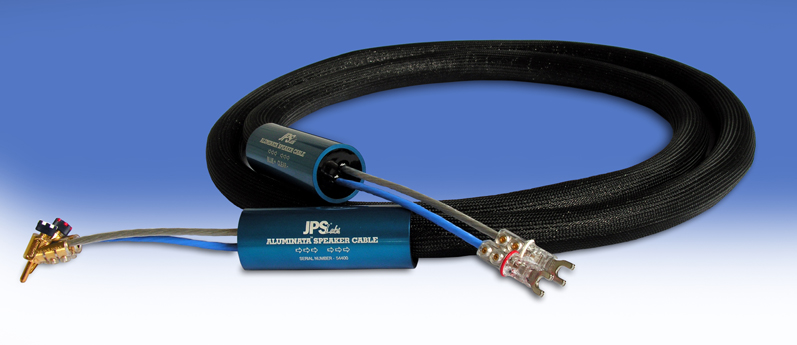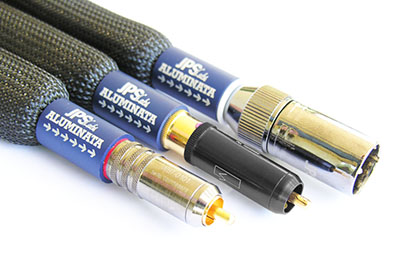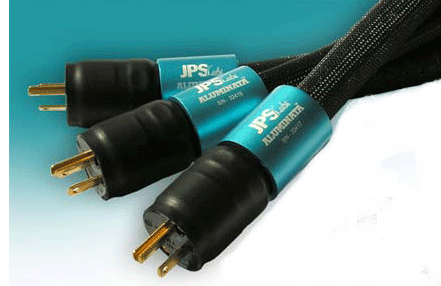JPS Labs Aluminata Reference Series Cables
|
JPS Labs Aluminata Reference Series Cables |
|
Unparalleled Clarity |
|
|
|
March, 2012 |

The trouble with wires is there is no soldering gun control legislation. Anyone can walk into a hardware store and walk out, $20 later, packing heat. No waiting period or background check required. Apply a little imagination to create AFEACM’s (acronyms for exotic alloys and construction methods—a.k.a. gimmick or shtick) and then claim your cables are, “revolutionary” and boast superior performance or at least better performance than products costing many times the price.
The field of wires is crowded and I have tried my share and know they are system dependent. Some sounded pretty poor in my system, but actual “bad” wires were in the minority. Maybe that was because I was particular about what I auditioned. The majority of wires was just uninspiring or did some things better, but not everything. Performance was also not uniform across all product lines or manufacturer. For example, a company’s interconnects might be excellent but their power cords would be disappointing.
Even knowing that, I girded my loins, mounted my trusty steed and charged that windmill. I decided to replace the hodge-podge of wire I had collected and use the same brand of cable throughout my system. I won’t recount the brands I tried and rejected. As I acknowledged, wire is system dependent. I did not spend a lot of time analyzing the performance of wires that disappointed, I merely moved on. Frequently there was a problem getting enough wire to do my entire system, so I had to make decisions based on just one or two wires. That may not have been fair since some products are very synergistic and work best when the entire system is the same. And that, in fact, was what I was looking for–synergy. But on the other hand, I was not looking for subtle or minor improvements and I was looking for wire that could live up to its hype and walk its talk across all products (interconnects, power cords, and speaker cables).
I also picked my battles by setting my own waiting period and background check. I concentrated on companies that had earned a good reputation for product performance and customer service. I was currently using a JPS Labs
Digital AC-X power cord with good results and had read good comments on other JPS products. Visiting the JPS Labs website I found numerous acronyms such as Alumiloy (a proprietary conductor), Particle Aluminum Shield (PAS), and End of Line (EOL) technology. Et tu Skubinski?

My curiosity fully aroused, I contacted JPS Lab’s President, Joe Skubinski, and asked if he could send me some Superconductor 3 (SC3) interconnects. Joe promptly shipped me several pairs of SC3 interconnects and also included one pair of Aluminata interconnects as well. He probably had an evil smile on his face as he placed the Aluminata in the box. And you have probably already guessed where this is headed.
Technical Stuff (a.k.a. Shtick)
There are too many design features in the Aluminata products to adequately describe here, so I will just give a brief synopsis with quotes and blatant paraphrasing from the website. The reader is referred to the website for more detailed information.
Alumiloy is the registered trademark of the proprietary conductors used in most of JPS Labs finished audio cable designs. It is composed of ultra-pure metals and other elements in a patent-pending composite conductor material.
Alumiloy conductors are used in both the SC3 and Aluminata products. In addition, Aluminata products use a Particle Aluminum Shield (PAS) which is created by diamond cutting an ultra-pure aluminum alloy into tiny particles. The particles are sifted through a fine grating to assure consistent size and then used to create a shield. The shield is about 0.5 inches (12 mm) thick on speaker and AC power cables but proportionately smaller on interconnects.
While researching current reflections, Joe found that electrical current, analogous to water flow in a pipe, reacts poorly to sudden starts and stops (e.g. an amplifier with sudden changes to power requirements). This constant change in current flow, particularly where the homes AC wiring is not as good as it could be, creates reflections or ripples all the way back to the breaker panel. To combat this phenomenon, JPS Labs developed End of Line (EOL) Technology, and incorporated it into Aluminata power cords to dissipate reflections within the cord itself.
This quote from the JPS Labs website resonated with me and was a major impetus for me to try the cables. “Most cable and wire place huge limitations on performance, while many more costly designs tend to tailor or adjust the sound, making a component’s response more like the wire rather than what it was engineered to be.” JPS Labs Aluminata products are specifically designed to avoid those problems. I subscribe to the same philosophy and later found the claim by JPS Labs to be truthful in my system.
JPS Labs takes great pride in their products. All Aluminata products are made and assembled in the USA by a highly skilled master technician. Every Aluminata Cable set is serial numbered and comes with a certificate of authenticity and an engraved aluminum case.
Gateway Drugs
As I said, my first experience with JPS Labs cables was with the Digital AC-X power cord. I wanted a good cable for my (formerly, Nova Physics Group) Laufer Teknik Memory Player, but the chassis on my early model would not accept large diameter IEC terminations. I need something smaller in profile and the Digital AC-X fit that criterion with a rectangular IEC termination. Because it was specifically designed for digital components I felt it offered great potential. Since then I have updated the chassis on my Memory Player and was able to compare the Digital AC-X against an Aluminata power cord.
A/B comparisons are slow with the Memory Player because it has to be rebooted each time and the connection between it and my laptop remote control program has to be reestablished. Because of that I did not do many swaps between the power cords. Differences were subtle at best and I decided the Digital AC-X was equal to the much more expensive Aluminata in that application. I have learned to accept small mercies whenever they find me.
But I have gotten ahead of the story. The SC3 interconnects did a very good job in my system. They were well-balanced and neutral with excellent detail and pace, rhythm, and timing (PRAT). They favorably compared to some interconnects costing three times the price. Readers Digest Review—they were keepers.
Then I swapped that lonesome Aluminata interconnect pair against SC3s between the Memory Player and preamplifier. It was the start of a revelation. That single cable dropped the system noise floor dramatically. No other cable had made a change like this. I understand why many are skeptical of cables. Most I tried made only minor changes and not always for the better. The Aluminata immediately caught my attention by being a standout. More importantly, it kept my attention and begged for more.
You don’t know what noise is until you don’t hear it.
I thought I had a quiet system. Come on now, I have a dedicated 20A circuit, high-quality outlet, and a power conditioner. What more could you ask for? Apparently the answer (to that question) is Aluminata.

Feeling a bit like Oliver Twist approaching the master, I asked “…please sir, can I have some more?” Joe promptly sent me additional Aluminata interconnects and power cords. In addition to the Alumiloy conductors, the power cords also have the PAS and use a Kapton® dielectric. I added them one at a time in the following sequence: interconnects between preamplifier and amplifier, two power cords on Quad speakers, power cord on preamplifier, power cord on amplifier. With the exception of the last power cord, each successive Aluminata insertion gave me more of what I had experienced before. Perhaps additional noise reduction was too subtle to notice at that point.
I added the power cords in a sequence that made sense to me but arguments for different sequences could also be made. Since then Joe has informed me, that while systems vary, the majority of the time amplifiers benefit the most from the use of an Aluminata power cord and sources come in second. Joe noted that doing each end of the system with Aluminata power cords provides the most beneficial use of a limited number of power cords. With Quads or other electrostatic speakers the end of the line for power cords is actually the speakers themselves. I noticed an improvement in all parameters when I placed the Aluminata power cords on the Quads and did not look back. Truthfully, with the improvements I was getting I had little impetus to keep moving them around. I just kept adding more.
I did not hear any tonal shift with the addition of the Aluminatas. What I did hear was better definition and music flowing from a black background. My single sentence review of the Aluminatas would be—“They are just so damn quiet”. I have never before experienced such a feeling of music flowing. I swear it was liquid. Reducing noise reveals subtle nuances like never before. I could hear farther into the music. Female vocals had more breath and seduction.
PRAT brings an emotional content to music. I have heard many systems that were balanced and tonally accurate but had little or no emotional content. They left me feeling empty. The Aluminatas in my system let the music connect with me. I should note here that the SC3 interconnects compared very favorably with the Aluminata with respect to PRAT. The additional noise reduction with the Aluminata interconnects only enhanced and emphasized that attribute. Of course I had already selected electronics and speakers that were capable of providing excellent PRAT. What the Aluminata did was allow them to do just that. It was depressing and maddening that other cables could have an opposite affect.
I was not done yet. Once again I went back for more. I had Joe send me some burned-in speaker cables. They made even more improvements along the same lines as the other Aluminata products. They also did something the other products had not. With the speaker cables there was a slight, welcome tonal shift in the lower and mid bass. Those areas gained a little body. I did not consider it enough to be coloration. When a shift is that slight, it is hard to decide if it is cable coloration or just a more accurate representation of the music and other associated electronics and speakers. Perhaps the Aluminata speaker cable was just doing the job better than my reference speaker cable.
 The utter quietness of the Aluminata cables provides the perfect blank canvas for Mary Gauthier to paint her somber and stark portraits. There is no place for noise to hide on the barren, “Falling Out of Love” and “I Drink” from the CD Mercy Now [Lost Highway B000765IS6]. Each successive addition of Aluminata products brought this recording to a new performance level.
The utter quietness of the Aluminata cables provides the perfect blank canvas for Mary Gauthier to paint her somber and stark portraits. There is no place for noise to hide on the barren, “Falling Out of Love” and “I Drink” from the CD Mercy Now [Lost Highway B000765IS6]. Each successive addition of Aluminata products brought this recording to a new performance level.
 On the CD Don’t Explain [J&R Adventures PRAR931391] by Beth Hart and Joe Bonamassa, Beth does an excellent cover of “Your Heart is as Black as Night”, a song written by Melody Gardot. While the Gardot version is filled with irony but not bitterness (almost amusement—boy, you sure fooled me), Hart darkens it down and her voice adds a touch of gravel and lingering ill will. The Aluminata cables capture the nuances and make each version an enjoyable listen on their own terms.
On the CD Don’t Explain [J&R Adventures PRAR931391] by Beth Hart and Joe Bonamassa, Beth does an excellent cover of “Your Heart is as Black as Night”, a song written by Melody Gardot. While the Gardot version is filled with irony but not bitterness (almost amusement—boy, you sure fooled me), Hart darkens it down and her voice adds a touch of gravel and lingering ill will. The Aluminata cables capture the nuances and make each version an enjoyable listen on their own terms.
I once auditioned some famous (and expensive) power cords that seemed to slow down my system. I know it sounds strange but everywhere I placed them I heard the same results. I suffered flashbacks to my ancient Walkman when the batteries would go weak. This is definitely not a problem with Aluminata cables. They disappeared and allowed the nimble-fingered duo Rodrigo y Gabriela to race their way through songs like “Tamacun” on Live in Japan [Ato Records B001FZSKMY]. No speed bumps there.
Good News/Bad News
The good news is that the Aluminata Reference Series is not the most expensive cable out there. The bad news is it is still expensive. More good news is that just one piece can make an improvement in your system. The other bad news is that you probably can’t eat just one potato chip. I couldn’t.
A major downside to the Aluminatas is their weight. A power cord weighs five pounds in the standard two-meter length. This makes for challenges keeping secure physical connections at each end despite the quality gold-plated Wattgate AC wall plug and IEC connector. The power cords are only moderately flexible which creates an additional challenge.
Interconnects weigh 2 pounds per 1.0M cable and use WBT premium RCA connectors or JPS Labs premium XLR connectors with gold-plated pins. The RCA cables were scary to connect to my preamplifier. The RCA connectors on my preamplifier noticeably flexed away from the chassis creating a gap at the top. I felt more comfortable with the XLR connectors.
The speaker cables were the easiest to work with because of the secure connections at each end and because the weight (8 pounds/8 foot cable) could rest on the floor.
Obviously Aluminata is not for every system. If you have done a good job with component selection, room treatment, and speaker placement and basically like your system but the final spark is missing, don’t start equipment swapping until you have tried some Aluminata products. Aluminata won’t fix basic system deficiencies like a noisy digital front end or poor room acoustics. They are not the solution to serious system problems. They are just the icing on an already well-baked cake. They are not flavor-straws and they won’t add romance to the sound of your system or to your life.
I find it very discouraging that wire can make that much difference but I have come to the conclusion that wires are components and just as important as what they connect. I can only report it the way I hear it. Remember the parable where a kingdom was lost for the want of a nail? A lot of excellent equipment has been needless traded because it did not have the correct wires. When a system reaches a certain performance level wires don’t just make a difference, they can make all the difference.
This is not to say Aluminata are the right cables for you or that you have to spend that much. Just be open to the possibility that wires could be the weak link (no pun intended) in your system. Ignore them at your peril.
Conclusion

I have poked some fun at cable builders. It was meant to be tongue-in-cheek but some might read it as head-up-butt. The bottom line is while I cannot testify that the Aluminata products would be the best for your system, I can without reservation say they are the best I have heard in my system. The transformation was that complete—unquestionable and unassailable.
Aluminata products in my system did not change tonality or radically alter the character of the system. They did enhance the strengths of my system. It was like getting an upgraded version of every component. All the things I liked about my system were improved. What I was looking for was maximizing the performance of each component and assuring myself that my wires were worthy of the task.
I was searching for cables that didn’t just disappear, but that got out of the way and let the music flow. I wanted cables that let each piece of equipment do its job, uncolored by the cables connecting them. I was also hoping for cables that would let me change equipment with relative impunity while at the same time making me content with what I have. Only time will tell if the Aluminatas can handle that Herculean task as I make equipment changes, but I am extremely impressed with the improvements in music flow and quiet background with no tonal shift. It is like the cables aren’t there. My Choice for Most Wanted Component 2011!

![]()
Specifications:
Aluminata Reference Interconnects: Quad 15 AWG Alumiloy solid core conductors (equivalent cable conductor size 12 AWG) with Particle Aluminum Shield
Aluminata Reference Power Cord: 8 AWG finely stranded copper alloy conductors with Particle Aluminum Shield
Aluminata Reference Speaker Cable: 5 AWG Alumiloy solid core conductors with Particle Aluminum Shield (Choice of 6mm or 8mm WBT spades or WBT locking bananas)
Price:
Digital AC-X Power Cord ($399/2.0 meters)
Aluminata Reference Power Cord ($3999/2.0 meters)
Aluminata Reference RCA or XLR Interconnects ($3499/1.0 meter pair)
Aluminata Reference Speaker Cable ($7799/6 foot pair)
Address:
JPS Labs LLC
7601 Seneca St.
East Aurora, NY 14052
Telephone: 716-714-5710
Email: info@jpslabs.com
Website: www.jpslabs.com
![]()
Don’t forget to bookmark us! (CTRL-SHFT-D)
Stereo Times Masthead
Publisher/Founder
Clement Perry
Editor
Dave Thomas
Senior Editors
Frank Alles, Mike Girardi, Russell Lichter, Terry London, Moreno Mitchell, Paul Szabady, Bill Wells, Mike Wright, and Stephen Yan,
Current Contributors
David Abramson, Tim Barrall, Dave Allison, Ron Cook, Lewis Dardick, John Hoffman, Dan Secula, Don Shaulis, Greg Simmons, Eric Teh, Greg Voth, Richard Willie, Ed Van Winkle, Rob Dockery, Richard Doron, and Daveed Turek
Site Management Clement Perry
Ad Designer: Martin Perry





Be the first to comment on: JPS Labs Aluminata Reference Series Cables